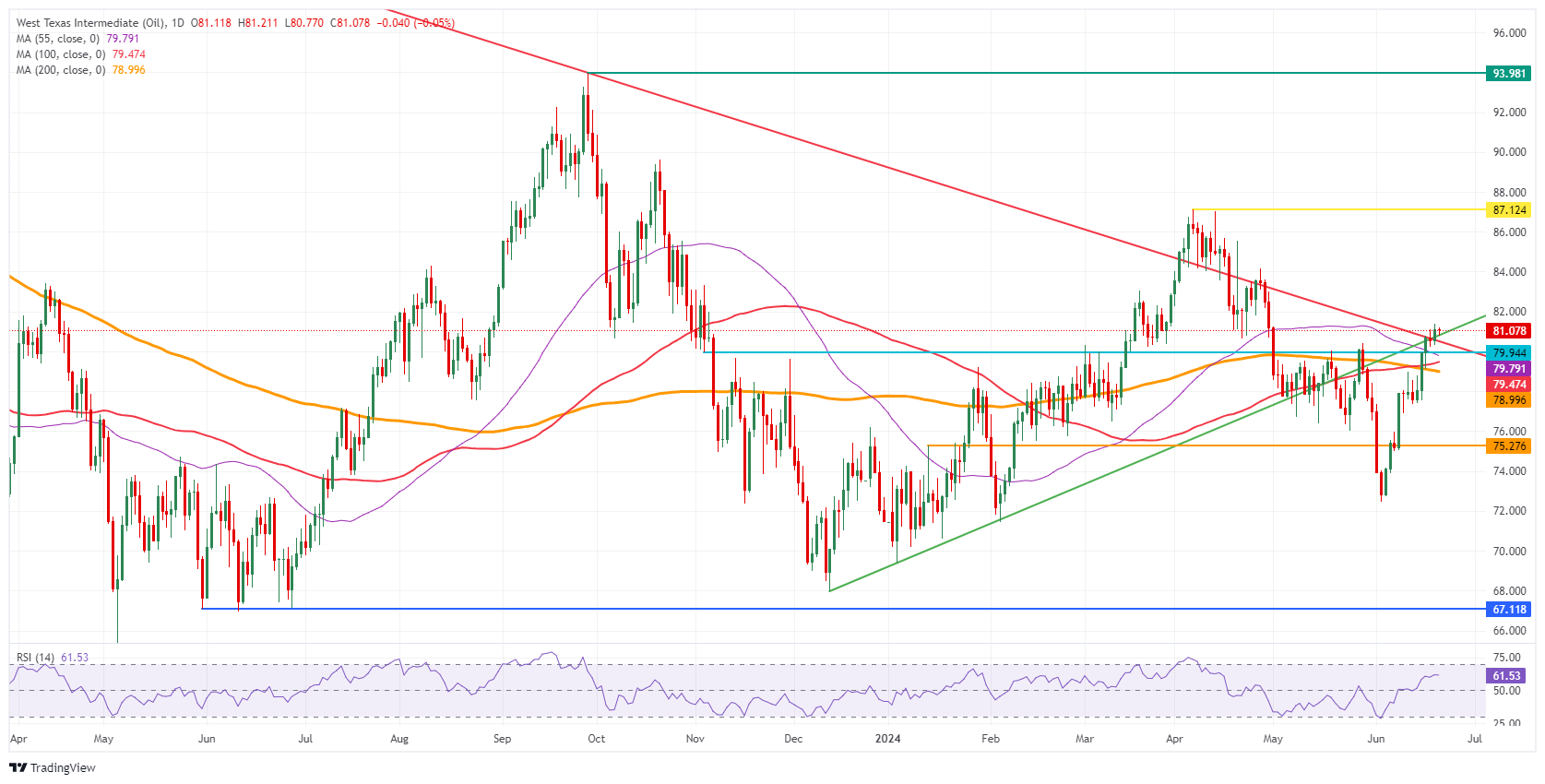- Oil prices are poised for a second straight week of gains despite facing profit-taking on Friday.
- Traders see an optimistic outlook for US demand in the near term as inventories fell more than expected last week.
- The DXY Dollar Index is trading firmly above 105.50, aided by the Japanese Yen and the Euro.
Oil prices retreat slightly on Friday but look set to close in the green for the second consecutive week, adding more than 7% gains in two weeks. The reduction in reserves in the US, combined with the southern belt of the US preparing for the first tropical storms, could mean some short-term supply setbacks.
Meanwhile, the DXY Dollar Index, which tracks the performance of the US Dollar against six major currencies, is comfortably in the high 105.00 area, approaching 106.00. The move began overnight when Nvidia (NVDA) lost $91 billion in market value in just one trading session, triggering a massive move toward the safe-haven dollar. On Friday, European Purchasing Managers’ Index (PMI) numbers signaled that the Eurozone economy is losing momentum, ahead of US PMIs later this Friday.
At the time of writing, Crude Oil (WTI) is trading at $81.00 and Brent Crude at $84.56.
Oil News and Market Drivers: Cuts Ahead of Hurricane Season
- The U.S. Energy Information Administration reported Thursday that crude stockpiles fell by more than 2.5 million barrels this week, more than the expected reduction of 2 million, triggering another push for crude prices. exceed $80.00, Bloomberg reported.
- Due to bad weather, the Corpus Christi area of Texas suspended most oil drilling and export activities. Mexico will also close some fuel import terminals, according to Reuters.
- Reuters reports that Mexico’s state oil company Pemex will begin processing crude oil at its Dos Bocas refinery in the second half of 2024.
- Baker Hughes’ U.S. oil rig count will begin to gain importance as hurricane season begins. This week’s issue will be published at 17:00 GMT, with the previous count at 488.
Oil Technical Analysis: The US market pulling its weight
The price of oil has managed to jump above a key level by reaching $81.00. It will be vital from here to first see if crude oil can resist profit-taking and achieve a daily and weekly close above this level. When that is the case, further upside could come into play towards the 2024 high at $87.12
To the upside, the red descending trend line near $81.00 has been broken and now needs to prove its resistance as support with a daily and weekly close above it. More room to move up towards $87.12, the year-to-date high (April 5). Previously, a relatively small pivot level would act as resistance near $84.00.
On the downside, the large Simple Moving Average (SMA) belt should now function as support and not allow further moves below it. That means the 55-day SMA at $79.79, the 100-day SMA at $79.47, and the 200-day SMA at $78.99 should prevent any decline below $79.00. If those levels do not hold, another drop back to $75.00 could occur.
US WTI Crude Oil: Daily Chart
WTI Oil FAQs
WTI oil is a type of crude oil that is sold in international markets. WTI stands for West Texas Intermediate, one of the three main types that include Brent and Dubai crude. WTI is also known as “light” and “sweet” for its relatively low gravity and sulfur content, respectively. It is considered a high-quality oil that is easily refined. It is sourced in the United States and distributed through the Cushing facility, considered “the pipeline junction of the world.” It is a benchmark for the oil market and the price of WTI is frequently quoted in the media.
Like all assets, supply and demand are the main factors that determine the price of WTI oil. As such, global growth can be a driver of increased demand and vice versa in the case of weak global growth. Political instability, wars and sanctions can alter supply and impact prices. The decisions of OPEC, a group of large oil-producing countries, is another key price factor. The value of the US Dollar influences the price of WTI crude oil, as oil is primarily traded in US dollars, so a weaker Dollar can make oil more affordable and vice versa.
Weekly oil inventory reports published by the American Petroleum Institute (API) and the Energy Information Agency (EIA) influence the price of WTI oil. Changes in inventories reflect the fluctuation of supply and demand. If the data shows a decline in inventories, it may indicate an increase in demand, which would drive up the price of oil. An increase in inventories can reflect an increase in supply, which drives down prices. The API report is published every Tuesday and the EIA report the next day. Their results are usually similar, with a difference of 1% between them 75% of the time. EIA data is considered more reliable since it is a government agency.
OPEC (Organization of the Petroleum Exporting Countries) is a group of 13 oil-producing nations that collectively decide member countries’ production quotas at biannual meetings. Their decisions often influence WTI oil prices. When OPEC decides to reduce quotas, it can restrict supply and drive up oil prices. When OPEC increases production, the opposite effect occurs. OPEC+ is an expanded group that includes ten other non-OPEC member countries, including Russia.
Source: Fx Street
I am Joshua Winder, a senior-level journalist and editor at World Stock Market. I specialize in covering news related to the stock market and economic trends. With more than 8 years of experience in this field, I have become an expert in financial reporting.








